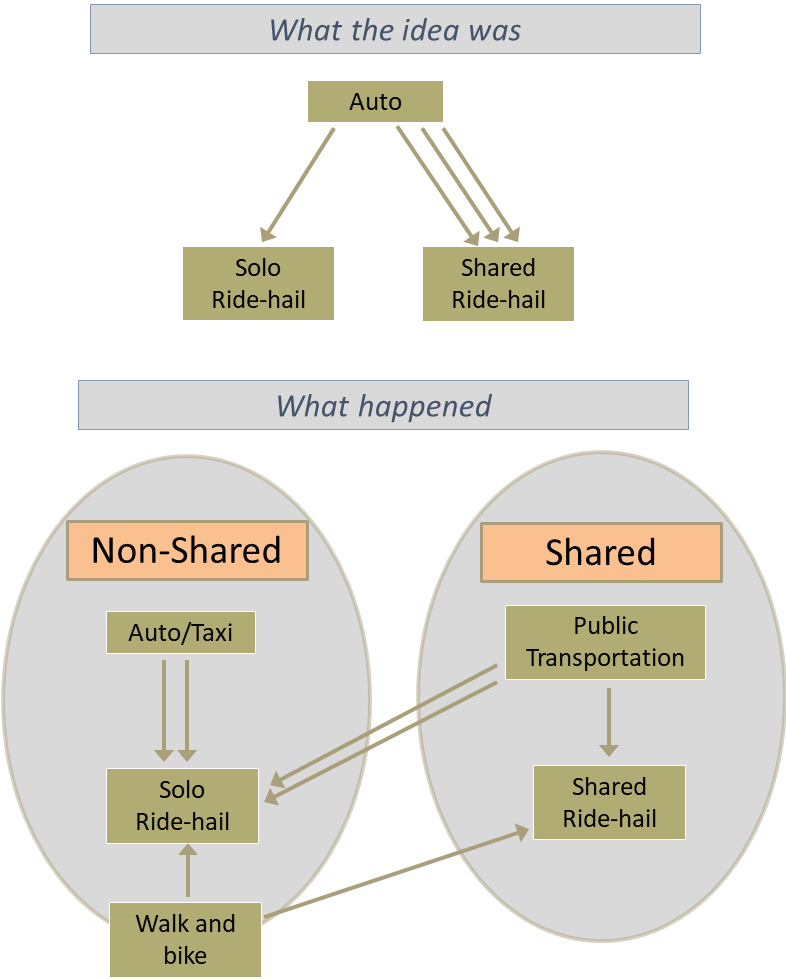|
Schaller Consulting |  |
| Home | New Mobility | Taxi, Traffic & Transit (Archive) |
Full article (pdf file) The popularity of Uber and Lyft and advances in autonomous vehicle technology have spurred public interest in the potential of shared ride services to reduce traffic congestion, vehicle emissions and space devoted to parking. However, research has shown that long waiting times, circuitous routes and privacy concerns might lead most patrons to choose exclusive-ride services over shared services (ride-hail or autonomous), thus increasing rather than decreasing vehicle mileage. This paper uses Uber and Lyft experience from 2014 to 2020 to examine the effectiveness of shared (or “pooled”) services in reducing vehicle miles traveled (VMT) in four cities with large concentrations of ride-hail trips and suburban areas of California. Taking into account three key inputs -- pooling rates, modal shifts and deadhead miles – results show that pre-pandemic levels of pooling led to at least a doubling of VMT when comparing ride-hail trips with patrons’ previous mode, with increases of 97% in Chicago, 114% in New York City, 118% in San Francisco, 157% in Boston and 118% in California suburbs. See Table 1 below. These large VMT increases are driven by the addition of dead-head miles before each pick-up and the absence of offsetting VMT reductions among travelers who switch to ride-hail from public transportation, biking and walking. VMT increases are only modestly mitigated by the use of ride-hail for “first mile/last mile” trips to connect to public transportation or by reduced cruising for parking by drivers in their personal vehicles. In sum, ride-hail adds to vehicle mileage for trips associated with ride-hail even taking into account pooling. Moreover, VMT increases have not been significantly mitigated by the use of ride-hail to connect to public transportation, or by reduced cruising for parking by drivers in their personal vehicles. Nor is there evidence of an overall shift away from personal vehicle ownership and use in areas with high ride-hail usage. These patterns are likely to endure in a world of autonomous vehicles given that auto users tend to switch to solo services due to considerations of travel time, reliability, comfort and privacy, while pooled options mainly draw patrons from sustainable modes like public transportation. A highly hypothetical scenario that leads to no change in VMT from ride-hail growth requires high rates of pooling, users moving predominantly from personal autos, and large reductions in deadheading, shown in Table 3 of the report. These benchmarks that would be difficult to achieve individually, and even more so in combination. The implication for public policy is that in dense urban areas, it remains important for policy-makers to prioritize space-efficient modes of public transportation, walking and biking. At the same time, ride-hail can clearly be valuable to meet specific needs such as providing paratransit services to people with disabilities, providing first and last mile connections to transit services and connecting late-night workers to jobs. These results will be important as cities emerge from the coronavirus pandemic and navigate a path to economic recovery, social equity, and environmental sustainability.
Graphical Summary Early expectations were that ride-hail service generally and pooling in particular would attract large numbers of auto users, as shown schematically in the upper figure.
Early expectations were that ride-hail service generally and pooling in particular would attract large numbers of auto users, as shown schematically in the upper figure.In reality, only a minority of patrons took ride-hail instead of their own motor vehicle. Many of those using ride-hail would have used public transportation, walked or biked had ride-hail not been available. Moreover, the large majority of auto users moving to ride-hail chose solo rides over pooled rides. This is shown in the lower figure. The experience with ride-hail thus underscores how the long-standing appeal of non-shared travel over shared service models has carried through to solo versus pooled ride-hail options. It is fundamentally this pattern of traveler response that casts doubt on the prospects of a mix of solo and shared services to lead to reduced traffic. For that, we need more high-quality, shared services.
|